June 27 - July 10, 2021: Issue 500
Angus Gordon OAM, BE, M Eng. Sc., FIE Aust., CPEng, NER, APEC, IPEA
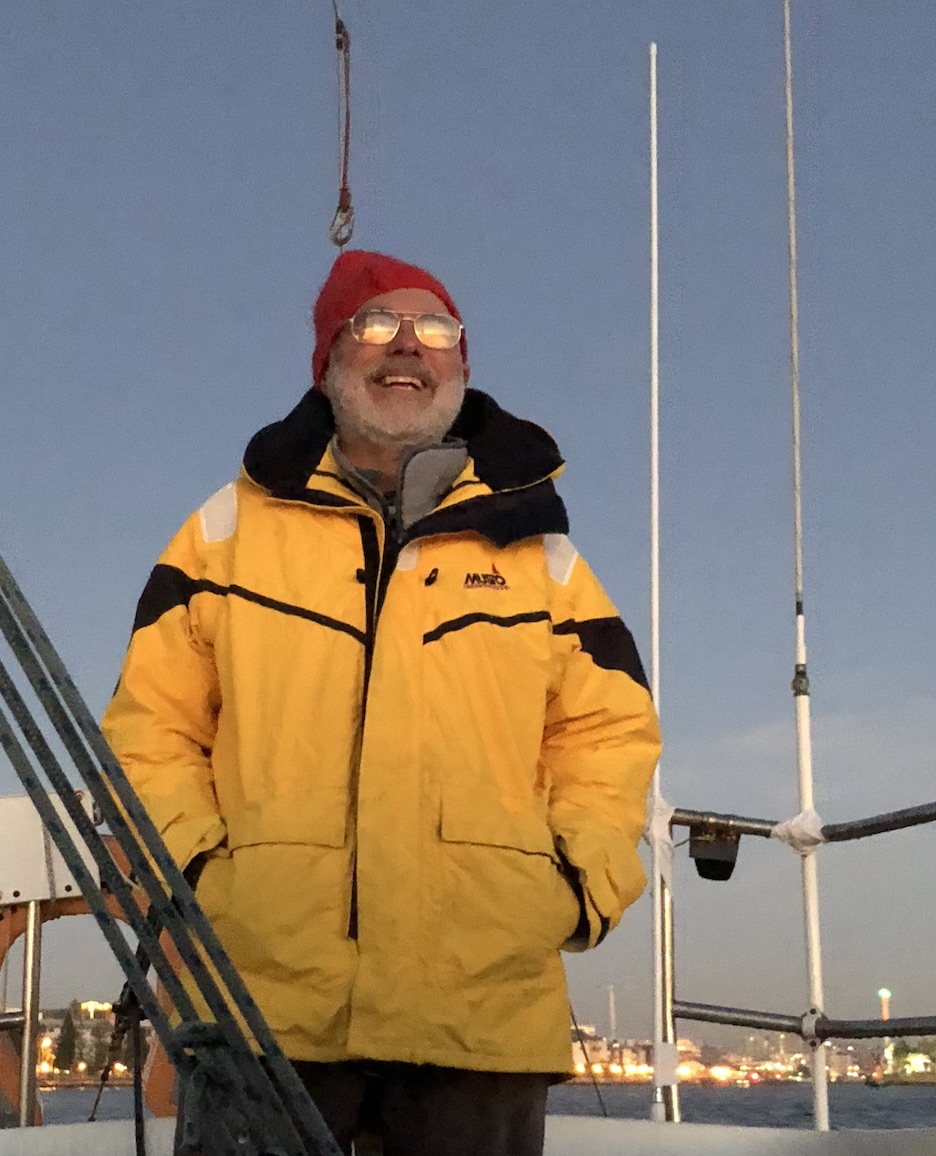
Departing Newcastle Harbour at dawn bringing my little 25ft yacht, Kindred Spirit, back down the coast
Angus has lived in the Narrabeen area since 1970 following his graduation as a Civil Engineer. He initially worked at the Water Research Laboratory UNSW and obtained his Masters in Coastal in 1973.
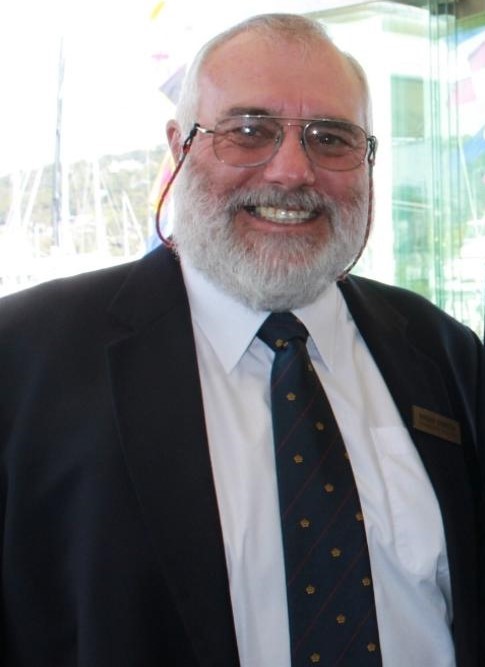 He has 48 years coastal management experience on projects in all states of Australia, and in Brunei, Dubai, Kuwait, Indonesia and Hong Kong. He has published over 80 papers, with an emphasis on understanding and using natural processes to manage coasts estuaries and lagoons.
He has 48 years coastal management experience on projects in all states of Australia, and in Brunei, Dubai, Kuwait, Indonesia and Hong Kong. He has published over 80 papers, with an emphasis on understanding and using natural processes to manage coasts estuaries and lagoons.
In 1976 he was appointed to established the NSW Government’s Beach Improvement Program and was subsequently involved in the development of the 1979 NSW Coastal Protection Act. He was appointed Manager Manly Hydraulics Laboratory in 1986 and General manager of Pittwater Council In 1996. He was Chair of the State Government’s NSW Coastal Panel and a member of the expert Panel that developed the 2016 NSW Coastal Management Act to replace the Coastal Protection Act. Angus was also appointed to the NSW Coastal Council advising the Minister administering the 2016 Coastal Act.
In 2005 Angus was awarded the Pittwater Medal and in 2006 the Manly Daily Environmental Medal. In 2018 he received an OAM for services to the environment, planning and the community.
Angus was a member of the Narrabeen Lagoon Committee and a founding member of the Warriewood Residents Association.
Renowned for his friendliness, his generous sharing of knowledge, practical and lucid approach to everything, Mr. Gordon's Profile is among the most requested by the community.
The Hon. Rob Stokes, MP for Pittwater, when notified of who was scheduled for Issue 500 with a request for a few words, kindly sent in an echo of the sentiments expressed by many.
“Angus has an incredible depth of knowledge and he’s kindly been an important sounding board to me for many years.
“His capacity for spatial thought and analysis, as well as his genuine love for Pittwater, is of benefit to our entire community.
“I was delighted to support Angus’ nomination for his Medal of the Order of Australia in 2018, and I appreciate his ongoing contribution on so many fronts.'' Rob said.
This Issue one of those most requested Profiles finally runs!
When and where were you born?
In Sydney in 1946.
GORDON (nee Betty Bell).—October 12 at Mater Maternity to Mr. and Mrs. D.W. Gordon of East Lindfield—a son. Family Notices (1946, October 16). The Sydney Morning Herald (NSW : 1842 - 1954), p. 24. Retrieved from http://nla.gov.au/nla.news-article17999202
Where did you grow up?
My early years were actually spent in Broken Hill. My father had been in the war (WWII) in New Guinea and after the war he became Head Teacher of Plumbing at Broken Hill Tech, he used to be a Plumber before the war. We lived in town – Broken Hill was an interesting place to live in those days.
My mother, unfortunately, was diagnosed with breast cancer when I was 7 and was having to make the trip to Sydney to be treated, which was pretty difficult in those days and meant that my father had to drive her down and that I was left for days by myself at that time.
We came to Sydney when I was about 10 years old and settled in East Lindfield – so it would be easier for her to receive treatments.
Where did you go to school?
Well, I started off in Broken Hill of course, but because of what was going on and all the disruptions involved I was infrequent in my attendance. When we came to Sydney I was in East Lindfield Public School.
I went on to North Sydney Boys High School for the funniest of reasons.
My mother actually died when I was 12, just as I was about to start high school, and amid all these disruptions I found out I was dyslexic – at 12 my academic performance was pretty abysmal. In those days they conducted what was called an IQ Test to determine whether you went to a selective school or not – which I totally failed and they spoke about whether I should be retested and go to what they called a “special school”. I had a very perceptive Headmaster who realised there were other issues going on and so arranged for another test – he cited some of the disadvantages I’d experienced in my past – and as a result of that I was enrolled in North Sydney Boys High. I was very lucky that the Headmaster felt that I was more capable than what the testing was showing.
You went on to the University of NSW from there?
Yes – although throughout high school I demonstrated I had the capability I didn’t demonstrate the performance and crashed out of high school. I pretty much failed every subject and at the end, at the Leaving Certificate I’d passed only one subject, which was Ancient History of all things – just the thing any Engineer needs.
Again, I was very fortunate that my teachers recognised that I was more capable than my academic record reflected. One of them contacted QANTAS and suggested I be offered a Commercial Traineeship, which QANTAS kindly did. Whilst I was there I realised I needed to lift my game and so I went to night Tech. while I worked during the day and as a result matriculated with a Commonwealth Scholarship. QANTAS were pleased and offered me a cadetship to do a commercial degree as I had actually done fairly well in their advertising department in what was called ‘reservations’ – so they felt I’d do well doing a commercial degree. In the time I was working for Qantas one of the jobs I had was working for Sir Hudson Fysh, (founder of Qantas) who was Head of the Board at that time. For about 3 months I was his ‘go-for’ – during those days everything came through the mailroom and telex machines and these were located in the bowels of the building so I had to make regular trips down to pick up the mail and telex communications. He (Sir Hudson Fysh) convinced me that Engineering was the way to go. So I went to North Sydney Tech. where they ran a “night school”. To matriculate I needed 6 subjects and there was only 5 nights in the week so each week I had to juggle my attendance – but again, thanks to fantastic teachers who understood when I missed a lecture, I managed to get through.
Why did you choose Civil Engineering?
In those days Civil Engineering was a broad range engineering – it was the all-purpose wide range Engineering degree. I looked at the courses at both Sydney and NSW Universities. At that time Sydney University was seen as the better university for Structural Engineering while UNSW was seen as the better for Water Engineering. So I chose UNSW as my interest was more in water than structural engineering.
And you went on to get a Masters in Engineering?
Yes. What happened was I finished my degree and in those days you did the Honours degree as part of the overall degree. Honours was based on your academic performance and your behaviour. When the results came out I was pulled aside by the Head of the school and told ‘look, academically you’ve qualified for an honours degree but due to your behaviour we’re not going to give it to you’. Because of my background and experiences I suppose I was a little bit rebellious. But having taken me aside to do tell me that he then offered me a position at the Water Research Laboratory at UNSW, which was an honour in itself. Whilst there I did my Masters while working on projects and subsequently was awarded a Masters in Coastal Engineering in 1973.
What was the first project you worked on there?
You will laugh at this but it’s actually the revetment wall that protects the Port of Botany, the massive wall there. It had actually been designed in England originally but they found to build it to that design could not be done and so they turned to the Water Research Laboratory to redesign the wall. I was working with the head of design at the WRL as a project engineer and that was a major project and an interesting way to cut your teeth.
Did you stay there long?
In 1972 the Uni then put me on as a full time Lecturer and were encouraging me to go further. I met my wife during my first year of university and we married once we both graduated, in 1970. We were then starting a family and unfortunately the remuneration from working at a university in those days wasn’t that good and so I needed to look elsewhere. The first thing that became available was working as an Engineer at Shoalhaven Shire Council. At the time most of the local government work for engineers in Local Government only required a Local Government Engineering Certificate, which was reflected in the type of work being undertaken. I was one of the few who had a degree qualification and had completed my degree during the commencement of computers and computer programming being introduced to engineering, so I was able to do quite a lot of work fairly quickly as I had access to what was then considered to be a “Main Frame” computer. The end result was that within a year I was pretty bored and swore then that I would never work in local government again.
While I was at Shoalhaven one of the things I was able to do using the computer was to work on putting together a number of studies to help with the sewerage systems, which then were quite overloaded also the Nowra water supply system was really overworked and so there was a lot of problems with both systems. To work a number of these problems out I utilised the computer programs that I had learned in the university through the knowledge I’d been fortunate to acquire. The other engineers at Council were great and had done excellent work but taking the broader overview presented an excellent opportunity to put together a number of grant applications which we got and we were then able to significantly improve and upgrade the water and sewerage systems. As part of these projects I came into contact with the Department of Public Works who advised me, ‘we’re looking at recruiting a number of new engineers and we’re prepared to offer you more money that you’re getting now – would you like to come along?’
And so, I joined the Department of Public Works in late 1973, just in time for the 1974 storms. The funny thing about that was I was the only qualified Coastal Engineer in the Department of Public Works – there were quite a few engineers in the Department that had been doing coastal works but I was the only one who was actually qualified. I was put in charge of the Beach Improvement Program, which was the program to restore the damage done by the May 1974 “Sygna” storm and the June 1974 storm that followed shortly after.
Over the next 10 years, in today’s terms, I ended up spending about 90 million dollars in coastal restoration works, including places along the peninsula – Palm Beach, Freshwater and Dee Why – it was much broader than that, but these are places people would readily recall.
What were you doing and what were these works going to achieve?
We were trying to restore beaches to what they may have been like naturally so they would be in a more sustainable form. For example, at Palm Beach, the northern end of Palm Beach, was all just mobile dunes and although it’s hard to believe today, during the 1974 storms the waves simply just washed through to Pittwater. What we did was build up the dunes quite significantly and then revegetated that area. One of the challenges was to source the vegetation to be endemic to that area for the restoration.
Another example is Freshwater – people today may not realise there was a sandstone wall virtually identical to the one at Manly. During storms the waves would run up to the wall, and then in 1974 the waves attacked the surf club’s front doors. We came up with the idea of building a dune right over the top of the wall. So today, all those dunes, now vegetated, were not there prior to these works.
Long Reef beach and surf club were so badly damaged Council was just thinking of filling in the Armco barrier and closing the road off. We were able to get in and build what I termed a “tripper wall” to redirect the lagoon entrance and rebuild all the dunes. Funnily people now complain that the surf club is too far inland. [Tripper Wall reference – include description]. Gordon, A. D. (2016). The “Tripper Wall” - managing the breakout of small lagoons and creeks across beaches. Proceedings 25th NSW Coastal Conference, Coffs Harbour, NSW, November 2016.
There’s a really funny side to the Palm Beach project; it took a long time to do the works and install the vegetation and the Palm Beach Association got very upset because they felt the restoration wouldn’t work, to the point where they actually complained to the Premier of that time and I had to front the Premier along with the Palm Beach Association to try to convince the PBA that the project should proceed. In the end it did proceed with the proviso that we had enough money left there so that if it didn’t work, we could strip all the vegetation and return it to what it was – that was what was agreed to.
Some years later, when I got to be General Manager of Pittwater Council one of the things that happens as a GM is you get invited to the Annual General Meetings of the local associations. The president of the Palm Beach Association at that time was the wonderful Bryce Ross-Jones. Bryce pointed out that he ‘knew me from the past’ (the meeting with the Premier) and then followed this by saying to me in front of everybody ‘and if you ever think of taking that vegetation out, we’ll kill you’ – or words to that effect.
During my time at council, I always found the local residents organisations an incredible asset for the community. On the council website we put up all this information to encourage their development and participation as well as providing information on how they could register themselves and protect themselves legally. To support these local organisations was a great aspect of our community as they function as a conduit that works both ways – they let you now early on if there’s a problem and in addition you can provide them with information about a matter and explain it and this contributes to the development of mutual respect and they can be very supportive of how you’re trying to meet their matters. I always found the residents associations were a very positive thing within our community. By far the majority of people involved in these associations are well meaning locals.
You first became involved in recognising the effects of climate change in 1976 – what were you noticing?
I was put in charge of the Coastal Section of Public works which involved the Beach Improvement Program but also general investigations into coastal erosion. Both I and my group were developing projections as to what may happen to shorelines in the future and of course, that impacts on people’s property, and of course people don’t like you drawing a line through their property and saying ‘this could be eroded’.
What concerned me was we were looking at these projections and basing these on the historical records we had, which was only in the order of 30 to 50 years, and looking at where the shoreline had been over those 30 to 50 years to determine where the shoreline would be or might be in the future. That’s ok but I had concerns as in doing that we were presuming that the climate was going to be the same in the future as what it had been in the past and I wanted to be sure that that was, as you might say, a reasonable engineering assumption to make and what’s more, a responsible one, given the effects this may have on people and their property.
At that time the CSIRO wasn’t really involved in the study of climate change and the only place that was publishing any material or looking into the effects of climate was the Antarctic Division of the Department of Science through their examination of ice cores. So, I went down to Melbourne University where the ice core work was being undertaken, as the Antarctic division in those days was in Melbourne. I spent some time talking to the glaciologists to try and get some idea of climate change. Funnily enough I ended up talking to the then Director of the Antarctic Division and was seconded from the Department of Public works to their science division. Subsequently I was supposed to go down to Antarctica as the Officer-in-Charge of the Mawson station to run the 1976 expedition when we found out that one of our daughters had leukemia. I talked to the Director and the decision was mutually agreed that I withdraw and spend time with my family. Unfortunately, our daughter didn’t survive but the 6 months was well spent with her at home.
At any rate, I became more and more interested in the issue and by mid 1980 the CSIRO had become more and more interested in the subject and approached me to write a chapter in their book called “Greenhouse 87”; the paper linked sea level rise to coastal erosion at 32 locations in NSW where my team had undertaken studies over the preceding decade. My chapter was ‘A Tentative but Tantalizing Link between Sea Level Rise and Coastal Recession in New South Wales, Australia’. Subsequent to that I became involved in the IPPC and have published a number of papers on climate change since then.
How many papers have you published?
Altogether it’s around 80.
What, to you, are the most important among those?
It’s a variety of subjects for a variety of reasons. Obviously Coastal Management has been a priority and so there’s quiet a number of papers on that. Climate Change has also been one, so there’s quite a few on that, in particular adaption to climate change. And Structural Design as it relates to coastal structures.
Could you please describe some of the bigger projects?
In 1986 Public Works put me in charge of the Manly Hydraulics Laboratory, which was just across the creek from the UNSW Water Research Laboratory which was really good as I knew the people there because of my previous involvement. Between ourselves we put together the Australian Water and Coastal Studies Company as a joint venture between the Dept. of Public Works and the Uni of NSW, and I was one of the Directors of that venture. The advantage of this was that it really opened up our ability to respond to needs both here and elsewhere and as a result I was involved in a number of projects including working in Brunei, Dubai, Hong Kong, Indonesia as well as projects across Australia.
One of the biggest among these was in Brunei. They had a major problem with coastal erosion. Somebody suggested I take a look at it. We did the Beach protection design and the model testing at the Manly Hydraulics Laboratory and at WRL. Subsequently the design was built. At that time the project cost 100 million Australian dollars. That was the early 1990’s. Now, 30 years later, it’s still there and shows the solution really worked.
The upshot of that was they then came back and said they needed me to design a harbour for them. I came up with a harbour design which was about 2 ½ times the size of Coffs Harbour and they built it. You can easily see this design on Google Earth. This time the cost was 200 million Australian dollars. These were the two largest projects I ever designed.
Another was one I did with Phillip Cox in Kuwait – they wanted to build a new city just to the north of Kuwait city for the Kuwait Government and we came up with a combined design that was about to be started when war broke out. I was packed and about to go the airport at lunchtime and my wife came in and said ‘well, you’re not going they have just announced that war has broken out’.
My wife and I were sitting at home watching the television and seeing the rockets going into the building in Kuwait City that I had been working from. So that was a close call.
Another was looking at the design of the ocean outfalls for Hong Kong and that’s because I and other colleagues had been involved in the design of the Sydney outfalls some years before. Although the Sydney outfalls are always under scrutiny within Australia on a worldwide basis they were seen as some of the leading examples of best practice.
How did you get into being at Pittwater Council as General Manager?
The short tale of this long story is one way or another I was away from home for quite a bit of time over a period of around 10 years. That meant I spent a lot of time away from the family. When I was home I participated in the usual community thing of council-bashing. At that time Pittwater Council had been over-extending itself and had got itself into a bit of a mess. My wife suggested since I thought it couldn’t be all that hard to run a Council, and given they had got rid of their second General Manager in the first four years of the new Council, that I should stick my hand up.
At the time I was in Hong Kong working on the design of the new sewerage outfalls. I actually flew back in on a Friday night went to the interview on the Saturday morning – I knew nothing about local government. In those days they did psychological testing of candidates and asked whether I was prepared to subject myself to the testing, to which I replied, ‘save your money I am clearly insane to take on this job.’ So, they gave the job – in fact I think that’s why they gave me the job.
I was still under contract to do the work in Hong Kong, and that was ongoing. I made an arrangement with the Council that I wouldn’t actually begin until the start of May. During the period leading up to May I would liaise with the Mayor and senior officers of the council when I was in Australia. This allowed me to come to a good understanding of what was involved. After May I still worked until September on the Hong Kong outfalls project but was able to commence the new role as I was able to undertake my role from Australia ‘after hours’ at the Council. The Directors of the Council, and the Mayor at that time, who was of course Robert Dunn, were really good people, so during the period I was still working ‘full time’ in Hong Kong I was able to get a good understanding of what was needed, where the issues were, and that stood me in good stead so by the time I actually started in May, I was able to make a good start on the pressing problems. The Council had a negative cash flow, a rapidly increasing debt and for the last couple of years had been the most complained of council in NSW. With the assistance of a very capable staff, fantastic support and involvement of the Councillors and, of equal importance, the support and cooperation of the community we were able to innovate major change. Within one year we had turned around the financial issues, reduced complaints to a level where we were well below many other councils and were delivering a wider range of services.
One of the first things we did was to settle the case of the Warriewood wetlands. The original price for this had been around 10 million and then it worked its way down to around 8 million.
Now the court had already charged Warringah Council 5 million dollars because of the delay, so that 5 million had already been paid. I offered to go to court to argue the Council’s case as an expert witness. The experts on the other side were familiar with my background and recommended settlement. By the end of my first week at Council a settlement was agreed which only involved the 5 million already paid by Warringah. We were able to turn things around pretty quickly after that had been settled as it removed a potential unknown liability that we no longer had to take into account.
By the early 1990s the Warriewood escarpment bushland was made up of a number of privately owned parcels either side of a central 11 ha area known as Ingleside Park. At the time the ownership of Ingleside Park was uncertain, but of the other parcels the two major land owners were Healesville Holdings, who owned about 28 hectares of land to the north of Ingleside Park and the Heydon family who owned a similar sized portion situated to the south of Ingleside Park. Smaller portions were owned by Mater Maria School and the Uniting Church. Regardless of this actual ownership pattern, many in the community were of the belief that the heavily wooded escarpment was public parkland and only a few, including David Palmer, President of the Ingleside Residents Association (IRA), knew that it was not.
In the early 1990s the NSW Department of Planning formally requested the newly formed Pittwater Council to prepare plans for a major land release of the Warriewood Valley/Ingleside area. Studies at the time indicated that the Ingleside region had a number of considerable impediments to overcome before it could be released for residential development. These included the need to significantly upgrade the water supply system, the provision of a sewerage system and the associated connection to, and upgrade of, the Warriewood Treatment Plant and the provision of a fit for purpose road system. There were also major environmental challenges such as management of the bushland including the endangered species of plants and animals, and management of the bushfire threat.
While to a lesser degree Warriewood Valley had similar strictures, these were far more manageable. However, unlike Ingleside, Warriewood Valley also had a history of flooding. Interestingly, I, in my previous employment by NSW Public Works as an engineer specialising in coastal and flood management, had as part of an investigation into flooding and water quality in Narrabeen Lagoon in the 1970s, developed a preliminary concept for managing water issues in Warriewood Valley. This involved a combination of restored and enlarged creeks with creek line corridors to cope with large rainfall events, along with detention structures and nutrient stripping pondage.
This concept was further developed in the 1980s, however it then became apparent that the successful management of flooding in Warriewood Valley was dependent on also limiting further rainfall runoff from the Warriewood escarpment and South Ingleside areas. Without such limits, and given the relatively flat nature of the Valley floor, any future development in Warriewood Valley would be vulnerable to flooding regardless of any actions taken within the Valley.
In late 1996 discussions took place between Council and the Department of Planning as to the future of what was then known as the Warriewood-Ingleside land release. Negotiations between myself and the Director General of Planning resulted in an agreed compromise which allowed for the release of 110 ha of land within Warriewood Valley, as a first stage. This excluded the “Buffer Zone” around the Warriewood Sewerage Treatment Plant (STP) and the escarpment region. The “Buffer Zone” around the Warriewood STP had been previously imposed to help risk-manage potential chemical spills at the plant as, at the time, chlorination was the final treatment process before the effluent was released at the cliff base outfall at Turimetta Headland. The 110 ha land release was formally announced in 1997 with Planning agreeing that Council could manage the “Release”.
The 1997 Warriewood Land Release helped focus attention on the concerns first raised by the Ingleside Residents Association (IRA) in 1994 regarding the future of the escarpment. One of the first issues identified was the question of ownership of Ingleside Park.
Research revealed that the central 11 Ha of the Warriewood escarpment was a dedication made back in the 1920s for the right to subdivide the “Blue Hatched Area” of the Ingleside plateau out from an original 1 square mile land grant to Joseph Kentigen Heydon in 1912 (the original land grant to another person had lapsed and Mr Heydon had informally taken up the grant in the 1890s but it was only formalised in 1912). The 1920s subdivision was prompted by a projected Gordon to Mona Vale railway proposed by the then Government. However, although the 11ha were set aside for “public purposes“ at the time of the subdivision Warringah Council failed to take up the dedication, so the land was in limbo.
Iris Hardie, one of my staff who was looking into sorting out the Pittwater property records for me let me know that the dedication had not been finalised. So, we applied to Crown Lands to have the property dedication correctly completed. After several months of argument, and record searching, and an extraordinary effort by Ms Hardie, Crown Lands eventually agreed that Council should be recognised as the rightful owners, in “fee simple”, rather than seeing it as Crown Land, surrendered by default as a result of Warringah failing to complete the dedication. In full in Campaign to Preserve Warriewood Escarpment
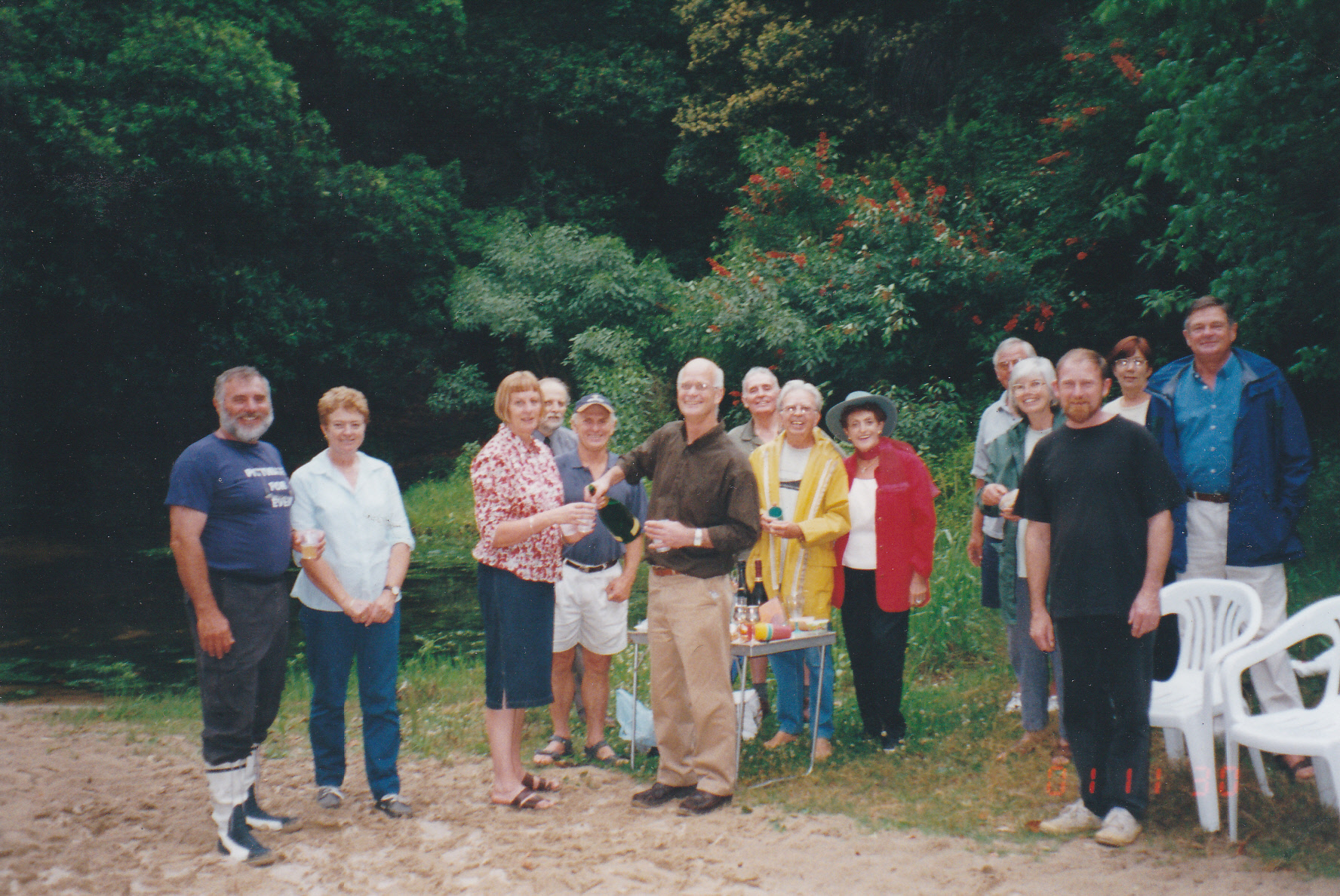
Celebrating the agreement to acquire the Heydon family land at Irrawong Reserve, December 2001. Left to Right: Angus Gordon, Julie Gordon, Libby Palmer, Henry Wardlaw, David James, David Palmer, Ian Giles, Jim Revitt, Patricia Giles, unknown, Marita Macrae, Gary Harris, Lynne Czinner, John Macrae. Photo: D James
A major early initiative was to reduce the delay and work involved around documents and providing accessibility to these. When I first started you had to do a lot of work to access these – residents had to go back and forth to Council to get paper copies of documents, and of course, some could get misplaced and then you were at start point again. I wrote my first computer program, in Fortran 4, in 1966. Since that time I’ve been very involved in the design, implementation and use of modern technology systems to re-design corporate delivery structures around what is now known as the Digital, or Electronic Revolution. So, I could reasonably be described as an “early adopter” of the Electronic Revolution, an economic, social and corporate age which we are really just entering in earnest. Because of this I was able to recognise that we could set up a digitised system that would enable residents and staff to access tall documentation in a much easier way. I had to first make sure the staff were up to speed in using computers and computer system and then we could apply this in a way that would benefit the residents and would also cut out a lot of the costs previously involved. We developed the systems we needed and were able to move the whole Council’s rationale for using these into the electronic age.
Within a few years we were winning accolades and awards for excellence including the Bluett Award in 2002 and numerous other awards for our electronic systems. To this end it was interesting to see the State Government announce its new ePlanning initiative recently, only twenty years after we first introduced a similar system in Pittwater; a system that has become the basis of ePlanning systems in many councils across NSW.
That system was quite revolutionary at that time, way ahead of what else was available then, and has now been applied across a lot of systems, enabling Councils, for example, in rural settings, where distance precludes being able to physically access required documentation – were you aware then that this electronic age would be rolled out elsewhere?
I put in a fairly big submission about this during the discussions for council amalgamations back in February 2016. In my view it is a backward step to create large organisations that by their very size have difficulties in being flexible and adaptive in the currently rapidly changing world. Many large corporations and retailers are suffering through their mistaken push for size in the last couple of decades, and are now finding smaller and more technologically advanced competitors are stripping them of their traditional customers.
In the mid to late 19th Century the “Industrial Revolution” took place. Some people, who thought they were leading edge thinkers, saw the fitting of auxiliary steam engines to sailing ships as a major breakthrough by increasing the efficiency of a centuries old industry of moving cargo by sailing vessels. An auxiliary engine made moving in and out of port easier and allowed vessels to continue on at 4 to 6 knots during calm periods. However, only a few decades on, the real forward-thinking people had all but eliminated sailing ships and replaced them with high-speed efficient turbine engines that allowed vessels to move at more than 20 knots, 24 hours a day. Soon fleets of non-sail ships were carrying passengers across the Atlantic in very short timeframes. However, again within a few years the transatlantic liners were replaced by aeroplanes and by the mid 20th Century man was landed on the moon.
Then we were in the early phase of the “Electronic Revolution”, an even more profound revolution than the Industrial Revolution. Already we have driverless trains and soon driverless cars on the open market. Most have access to the internet and most young people use it, and in particular, social media, daily; something that many of my age still don’t understand, and worryingly many senior executives in government and private enterprise think they understand because they can use email and Google, but actually don’t have any real understanding of the real power and future of the Electronic Age.
When it comes to local government reform, we seem trapped in the 20th Century time warp of “economies of scale” based on “efficient use” of human resources, but not accounting for the potential availability of electronic systems. You only have to examine the reports by the States two advisory bodies on local government reform to realise that at best their thinking was that of those who thought fitting auxiliary engines to sailing ships was a great leap forward into the future, when there are others of us who have already installed systems that are analogist to the technology of the transatlantic liner of the past but more importantly can just visualise the “man on the moon” scenario of the Electronic Age.
There are two parts to councils: one is the elected representatives while the other is the administration. Elected representatives are the feature of a democracy; administration is the tool for implementing the practical desires of a communities elected representatives (practical because they also have to be affordable). Historically the two have been seen as one organisation. Now, because there is a dull recognition of inefficiencies within bureaucratic administrations, the equally dull “solution” is to throw away the “baby with the bathwater” and reduce democratic representation (which actually doesn’t represent a significant cost in a council’s budget) on the grounds of the bureaucratic inefficiency of an out of date administration. Is there a need for better standards for councillors? The answer is that in some cases demonstratively yes. However, is there any evidence that larger councils solve this problem? The answer is demonstratively NO, rather the opposite.
Smaller, more flexible and adaptive councils can, and do, capitalise on using more flexible local businesses. This demonstrably has great benefits both in terms of quality and delivery time of outcomes but also in stimulation and support of the local economy and community. This becomes even more apparent as businesses are taken over by nationals and multinationals and have an increasingly less interest in actual local outcomes, but can afford the legal support to force purchasers to comply, rather than the other way around. Sadly, there are many examples of this. Big councils are more easily, and financially rewardingly “picked off” and there are certainly many examples of this occurring.
While big councils tend to take on more ambitious projects than smaller councils, evidence demonstrates that their failures are to a large degree a result of the extended lines of communication that exist in large organisations. These longer lines result in information either not getting through or getting through in a “modified” form. Smaller councils = shorter lines of communication and a tendency to use external expert consultants rather than attempting to do things in-house with less expert staff.
What I have already mentioned is the benefits of a very engaged community. Pittwater then, with an estimated population of 63,000 operated 9 surf clubs, 7 Rural Fire Services Brigades and a large number of bush care groups. This was and is a reflection of the cultural environment which sees the smaller Pittwater community operating far closer to the council and being an engaged “community of interest”. To be fair, the residents in the northern area of Warringah, and in particular those in the Narrabeen Lagoon catchment and at Terry Hills and Duffys Forest are much closer to the Pittwater community than the rest of the Warringah community. Again, this is understandable because the natural environments are very similar, with the same challenges, opportunities, management requirements and needs to work closely in partnership with Council.
The water body of Pittwater is also a defining part of our “culture” - Pittwater has 7 yachting and sailing clubs with a total of several thousand members, over 1,000 boats in marinas and a further 3,500 boats on moorings and several hundred junior sailors. This easier access to water at a number of locations favours a greater active involvement by Pittwater residents in what happens in their community.
Pittwater also has a large area of National Park and of bushland parks, and hence there tends to be a greater trend towards voluntarism in maintaining the natural environment. Pittwater, with 7 “offshore” communities living in areas only accessible by boat, and all but one actually located within what could be seen as the overall boundaries of the National Park. People go to work by boat, children go to school by boat and it is interesting how the offshore communities blend in, work with and contribute to the overall culture of Pittwater.
All this defined and made a great local Council. The systems we installed were the opposite to the ‘last century’ thinking that sadly seems to be the driving force of the State Government.
We were able to increasingly operate at a much better level by moving more and more of what needed to be done onto Electronic systems. What was done was recognised not just by the Real Estate agents, who adopted a similar system soon afterwards, but also by solicitors – For example we were the first Council to put the 149 certificates online in such a way that if you were going to an auction you could pay your money and within 3 minutes you could access a full 149 for the specific property you were interested in and therefore, in real time, know the planning strictures that applied to that property.
When we got all the 149’s sorted out, it meant we knew all the attributes associated with each property, and the planning strictures that applied to that property. We were then able to build a system where you didn’t have to obtain and read all the planning instruments such as the LEP’s and DEC’s and State Planning Instruments that applied to the property in question - all you had to do was, online, tell the system that you wanted to build a swimming pool, for example, and provide the address was – everything else was already linked and in place. The system was built in such a way that it could interrogate itself and automatically produce a document that said: ‘this is what you need to do’.
The next stage, which we were just starting to do when I left Council (retired), was to enable you to do a test on the issues involved in any proposed development so you could resolve those prior to submitting your application for a development.
I recently had a friend remark that the State Government Planning department is now only 20 years behind what we were doing at Pittwater Council then.
One of the keys to making computer systems work, and to be able to replace operations with them, is that you have to think from the point-of-view of the user, not from the point of view of the program designer. You have to keep asking yourself the question; ‘if I was the user how would this work best for me’? There’s no point concentrating on writing an efficient program if everyone it is designed for can’t use it.
You and your staff got Pittwater Council to a point of surplus through these structures and the implementation of these ideas to the point where the Council now in charge of the Pittwater area is still spending Pittwater Council money for these. That must feel good?
Yes, it’s interesting – and of course in 2002 we won the Bluett award and part of that was, again, that Pittwater Council staff prepared the magnificent documents for this from the systems we had installed which showed what had been done.
My view about awards is they are merely badges on the sleeve – but the Bluett people came to me and said ‘are you going to put in for the award’ and I said ‘nup, not interested – I have better things to do at present.’ However, it was obvious they recognised the work we had done and wanted to make that more broadly known –to help other Councils see what could be done and what the future in good local government might look like. So, I relented but we only put in a very slim submission which simply highlighted what we had done and they surprised us by saying ‘yep – you have got the award’.
Pittwater Wins Bluett Award
Pittwater Council, on Sydney’s northern beaches, has won the AR Bluett Memorial Award for 2002. The award – announced in June 2003 and presented in September – recognises the greatest relative progress made by a NSW Council in the previous year.
Pittwater Council, formed just ten years ago, covers 125 square kilometres and is home to some 56,000 people.
The award citation recognised Council’s “outstanding progress in the delivery of Local Government services to the Pittwater community”.
“Council completed an impressive program of special projects and public works utilising funds generated by asset rationalisation, development contributions and levies,” the citation reads. “The fact that Council was judged to be the most progressive in the State in only its tenth year of existence was particularly commendable. The Trustees were impressed with the breadth of services provided and the sound approach adopted by Council in using information technology to expand and maintain service efficiency.”
Council’s award submission included the acquisition and environmental upgrade of a major part of the Warriewood Ingleside escarpment, and 11 additional hectares of foreshore parkland at Winnererremy Bay in Mona Vale.
Other achievements included the construction of the Avalon Recreation Centre, which won a building excellence award, and the building of a Northern Beaches Indoor Sports Centre, in partnership with local schools, community groups, and the State Government.
Mayor Patricia Giles said Council was absolutely thrilled to accept the award, which she describes as “the pinnacle of excellence for Local Government in NSW.
“We are proud of our achievements and delighted to have been publicly recognised,” she said. “This is proof that smaller is successful, and bigger is not better.”
Only two Bluett Awards are bestowed each year, with Pittwater winning the Local Government Association section. The Shires Association section was won by Tenterfield Shire Council.
Retrieved from; https://www.lgfocus.com.au/editions/2003-10/pittwater-wins-bluett-award.php
What were the biggest projects you undertook while at Pittwater Council that you’re happiest with?
The biggest one is probably the Library at Mona Vale. We had a pretty basic old library there to begin with, and the Mona Vale Memorial Hall and a Baby Health Centre to begin with in those days. We needed to upgrade the library, and we also wanted to have a shopfront for the Council in the area. I started to put together a proposal that would minimise the impact and put us on the Village Park, for which we’d have to take over a bit of that space. I got in touch with Crown Lands, who own Village Park, and said, look we need to redo some stuff and we need to use part of Village Park to do so and gave them the list of our works in our proposal.
Crown Lands came back with a letter which stated they would not authorise the Council to put anything more “on” Village Park.
So, I said, ok, we’ll put it under – and that’s what we literally did. I sent a letter back stating, ok, we won’t put anything more “on” Village Park, we’ll just make good use of what we already have (the footprint of). The funny thing about that was, as an Engineer, I knew what the fundamentals were in building a good building, but as a General Manager I was empowered to do a whole pile of things that I’d always wanted to do, but previously hadn’t had the authority. Although an underground library is not at first sight a spectacular Public Building it is surprising how soon it is seen as such. We found that once the architectural plans were done etc. it would cost less to go underground than to place some new “imposing public structure” atop the ground. Another aspect of the concept was that the air-conditioning requirements were dramatically less – and what’s more, provided a far more stable environment. For the underground library, one of the big challenges was the waterproofing, and for me, as an Engineer with a background in Water Engineering, I had a ball working through this aspect of the design and construction.
Ultimately it didn’t use that more of the surface of Village Park as the old Baby Health Clinic was removed, and its functions merged into the overall development concept. The new underground library meant we could reuse the old library building and revamp that into a Service Centre for the community and the Early Childhood Centre that replaced the previous Baby Health Clinic. This project, and the way we approached it meant that we could also then revamp the adjacent Mona Vale Memorial Hall and create a multipurpose community centre. More in: Mona Vale Library Celebrates 10 Years at Village Park - 2014
It was the same at Avalon – the Avalon Community was a broken-down old structure and the Avalon library was located in another building at that stage. The problem there was that the whole was on a flood-prone area – rather than walk away from it as ‘too hard’ we built the new building so it was elevated out of the flood zone and we designed the building so it made good use of the great air circulate that is associated with the Avalon area. We also focused on building a structure that maximises the use of natural light. We were able to integrate an existing public hall, on the site, into the new building to become a multi-purpose space to be of general use for the community. Again, as with Village Park an old, poorly used, Baby Health Clinic was incorporated into the new building as a modern Early Childhood Centre.
That whole project at Avalon was, again, great fun, and an example of how innovative design and ideas, coupled with community passion and support, can manifest great solutions for purpose built public buildings on challenging sites.
Another project was, of course, Winnererremy Bay. The more you came up with innovative solutions to these things the more the Councillors and council staff was fired up to deliver them – they all just got stuck into it as one great team, with fantastic community support.
It’s not just Pittwater Council that you have helped out Angus, you have also been a member of the Warriewood Residents Association and one of the Executives on the Pittwater Environment Foundation – why did you get involved with these local organisations?
The Warriewood Residents Association was to do with the fact that once I’d retired from work and my position at the Council I felt I needed to use my knowledge and skills as ‘the resident from hell’ again.
How did you exercise your ‘resident from hell’ acumen Angus?
There were some good people that were very concerned about what was happening in Warriewood valley but were unsure as to how to go about addressing the issues – great people like Chris Hornsby and his wife Julia, who’d done a fantastic job over the years- it was a question of ‘how do we do something?’. So, I helped equip them with how to best communicate with Council and achieve things, and in the early days did some liaison with Council myself, really to keep things on track with what had already been decided for Warriewood valley.
Nowadays, every now and again, Chris or Julia will contact me with questions about things, but nowadays I don’t have that much involvement with them for no other reason than I think they’re doing a fantastic job.
Pittwater Environment Foundation, are you still involved there?
Yes I am, in fact I’m addressing the Council on this at present. A couple of the councillors rang me up and said the PEF has gone into a bit of a hiatus post the amalgamation and it was time to put it back on a footing where it was achieving outcomes again. The Council were at the stage of appointing a panel of Directors to do this and approached me to ask if I’d be prepared to be a Director for a while to look at the corporate governance issues. There are some fantastic Directors now on this and Marita Macrae is the Chair – Marita is someone I’ve had dealings with for a long time, even back to the Public Works days working with her in providing funds to help save the Avalon Dunes. I can’t think of anyone who is as dedicated as Marita is and yet never looks for any acknowledgement or praise. Flying under the radar has become a speciality in her case. I’m not sure the community is aware of how much work Marita has done for decades to look after what so many take for granted here.
Angus, you were the founding President of the Down Syndrome Association of NSW – where did that come from?
The daughter that we unfortunately lost from leukaemia was our second child. She was born with Down Syndrome. In those days they basically took the baby away in the delivery room without any explanation – they made some kerfuffle about how there was a problem and they’d explain it all tomorrow. So, they took her away before we really got a chance to even see her, let alone hold her. The next day I got a phone call that I better get down to the hospital as my wife was in tears, very upset. I thought the worst of course. When I arrived they said, ‘look, your daughter has Down Syndrome, we recommend that you don’t even see her, we can make arrangements for her to go into a special facility, an institution, where she can be looked after (out of sight)’, and all this other stuff.’ Basically ‘don’t see her’ and ‘don’t get emotionally involved’. We were absolutely opposed to that. The advantage I had was that when I was at university, in addition to my engineering I’d undertaken a two year “humanities” course on psychology and in doing that I’d undertaken a major assignment on what was in those days called psychology IQ and of course questions about Down syndrome had been part of my research. So, I had a fair amount of grounding and understanding in what Down Syndrome was.
So, we said, forget it, give us our daughter.
We had her for two and a half years before the leukaemia took her life. We don’t regret taking her home at all. We knew in ourselves that we’d do and had done everything we could. We still remember her with both sadness, and joy. We have three wonderful children and now six grandsons but there is also a little girl always by our side.
The thing was we realised other people were being told the same as we were when their child was born, which was just wrong. So, a few of the parents who were keeping their children and wanted to bring them up themselves, and also Macquarie University who were running an early intervention program for Down Syndrome were demonstrating that Downs people could lead happy and meaningful lives in the community. However, there was no state-wide organisation that was supporting or disseminating information to assist parents to make an informed choice. So, my wife and I, along with some other parents, were talking about this one day and we decided what was needed was to set up and organisation that could do that.
I went and saw Tom Webster, who was our local Member at the time, and he introduced me to the Minister in charge of Child Support who arranged an initial funding grant and from that we established a little library of information, some advice services and founded a roster of parents who could be able to go around and talk to new parents in the hospitals, explain what it was all about.
A couple of years ago I was invited back to a celebration of 35 years of the Down Syndrome Association of NSW and it was fantastic to see what has now been done. There were kids there, when I say “kids” I mean Down syndrome people I recalled from years ago who were now in their 30’s and 40’s who were having a good life and with whom your could have a very sensible conversation. They understood what was going on in the world – some of them had driven themselves there, to the function. One guy was actually a computer programmer – so from being taken at birth and locked away, hidden, we now have this – and that’s what it should be.
Now Australia wide: The associations have come together to represent and progress the needs, interests and aspirations of people with Down syndrome and those that support them. www.downsyndrome.org.au/nsw
Ok – let’s go sailing Angus; you started, at the Royal Prince Alfred Yacht Club, the Schools Sailing Program and the Youth Development Program, which has given so many kids such big opportunities and is among the best programs the RPAYC still offers. How did you identify that need and get these going?
Well, you see, the funny thing is, being able to go sailing was probably what saved my life. You know I was saying I was a failure at school? Which I was, and it meant I had very low self-esteem. Well, I think it was my second year at high school, when I was about 14, one of my friends brought in some plans he’d bought for a Moth sailing boat. He decided that it was all going to be too hard to build and that he couldn’t do it. I took the plans and went home and started building.
Now, at that time I was seen by everybody, including my father, as a total failure. Then all of a sudden I was building this boat. I finished the boat, then I started racing it, at Balmoral. I soon found that if I built a new boat each year, raced it successfully and sold it I could not only afford to build a boat a year I could also pay for my sporting costs from the profit I made.
Of course, I knew nothing about sailing to begin with – so the one key characteristic I developed was that if I thought I couldn’t do something I would make it into a project, which I would take on in parts, and so I was able to overcome major challenges. I applied that approach to anything which I thought ‘I can’t do’ at first.
From that I’ve now been racing for over 60 years, with some good results, also some bad results, but always learning and that is what gives you satisfaction apart from the underlying enjoyment of the sport. Naturally when I had my own children I began building boats for them as well and getting them involved in sailing – which they all still love and are all still heavily involved in. In fact, they’re all grown up and have their own kids and are involved in sailing with their own kids as well.
When I was involved with David Lyle at Avalon Sailing Club, and also John Gordon at BYRA in teaching young people how to sail, it became apparent that there was nothing really available in taking people from learning how to sail, and maybe even winning championships in those little dinghies, to turning them into people who could move into being able to sail in the yachting spheres and into world standard sailing events.
The Royal New Zealand Yacht Club had come up with a really good program, which they called their Youth Development Program – a really world leading club and a really good program. The RPAYC became aware of that program and took a look at it but for a couple of years it went into abeyance because it became apparent there was going to have to be a lot of effort in getting sponsorship, purchasing boats, and the training up and coaching etc., it looked as though it was going to stall.
At that time I was looking at taking a year off from what I was doing, then working as Manager at the Manly Hydraulic Lab. I went and saw the Director General of Public Works and said ‘look, I think I need another year off (my previous year off with was with the Antarctic Division), or if you like, I’ll resign.’. the response was ‘nup, you don’t get to resign – take another year off’.
So I went to the club to set up a Youth Development Program on the basis that I had to get the sponsorship for myself and also for the boats and all the equipment we’d need. Funnily enough Caltex came on board fairly early for sponsorship because they were just launching their “Starcard” initiative and there was an Executive from Caltex who was involved with the club and was able to collar a dollar or two for the program and hence the first Elliot 5.9m yacht was named “Starcard”. Another company was one that had put a lot of money into the New Zealand program, which was Fletcher Constructions. They were starting to trade in Australia, building marinas using floats, but they didn’t have much coverage in the market, so I managed to get them to put a fair amount in. Within the year we were able to buy four brand new yachts and a couple of inflatables. Subsequently a number of others got involved including North Sails, Bosun’s Locker and members from the club, and a number of other people and businesses.
I realised we needed a lead into the program – so I developed the Schools program to encourage local schools to take up sailing as a sport (Pittwater High had had sailing as a sport for many years under the initiative and driving force of teacher Wal Wardle) – so, with the sponsorship money we bought a number of pacer hulls (12 ft dinghies) and I just rigged them with what I could scrounge up. I then went around to the schools and said, ‘we’ve got the boats, how about setting it up as a school’s sport?’.
We got cooperation from a number of the schools and the Schools Program was soon underway.
With the Youth Development Program we advertised the opportunity to enrol and I put together a program based on the NZ model. I undertook the first year of coaching. All of the people that went through in that first year are still very much involved in sailing; they’ve done Round the Worlds’, America’s Cup, all sorts of world standard events, and are still involved at a club level as well except one, who decided to become an airline pilot. And he was a very good sailor I have to say so it was a pity to lose him to the sky.
After the year finished I wanted to go back to my “real” job. As it turned out my eldest son, Traks, who had just completed his course in Sports Management in Canberra University, took over my job and was the one who originally trained James Spithill, something James kindly acknowledges.
Traks Gordon is a legend in Pittwater! What a wonderful family. But that wasn’t enough – you then took on the role of Commodore at the RPAYC?
Yes – my life is a bit like a stagecoach going out of control downhill sometimes. I never really had ambitions to do most of the things I have undertaken including the Youth Development Program. My view is I had gained so much from the sport of sailing that I had to give something back. I really think for those things that have given you so much there’s an obligation on you to give something back.
Once I’d retired, from my job at Pittwater Council, the Directors of the Board at RPAYC asked if I’d take on the role of Commodore. There had been someone lined up to be the next Commodore, but there had been a series of things that made that unable to happen. When I was asked would I like to be Commodore my answer was ‘not at all’ – but the response was that they needed somebody and I had been involved across most of the divisions within the Club. I said I’d do it if nobody else put their hand up – nobody did, and so I did three years, which is the standard for the Club, three years for that position is enshrined in the Constitution. As always, while a somewhat reluctant conscript I put my best efforts into the role.
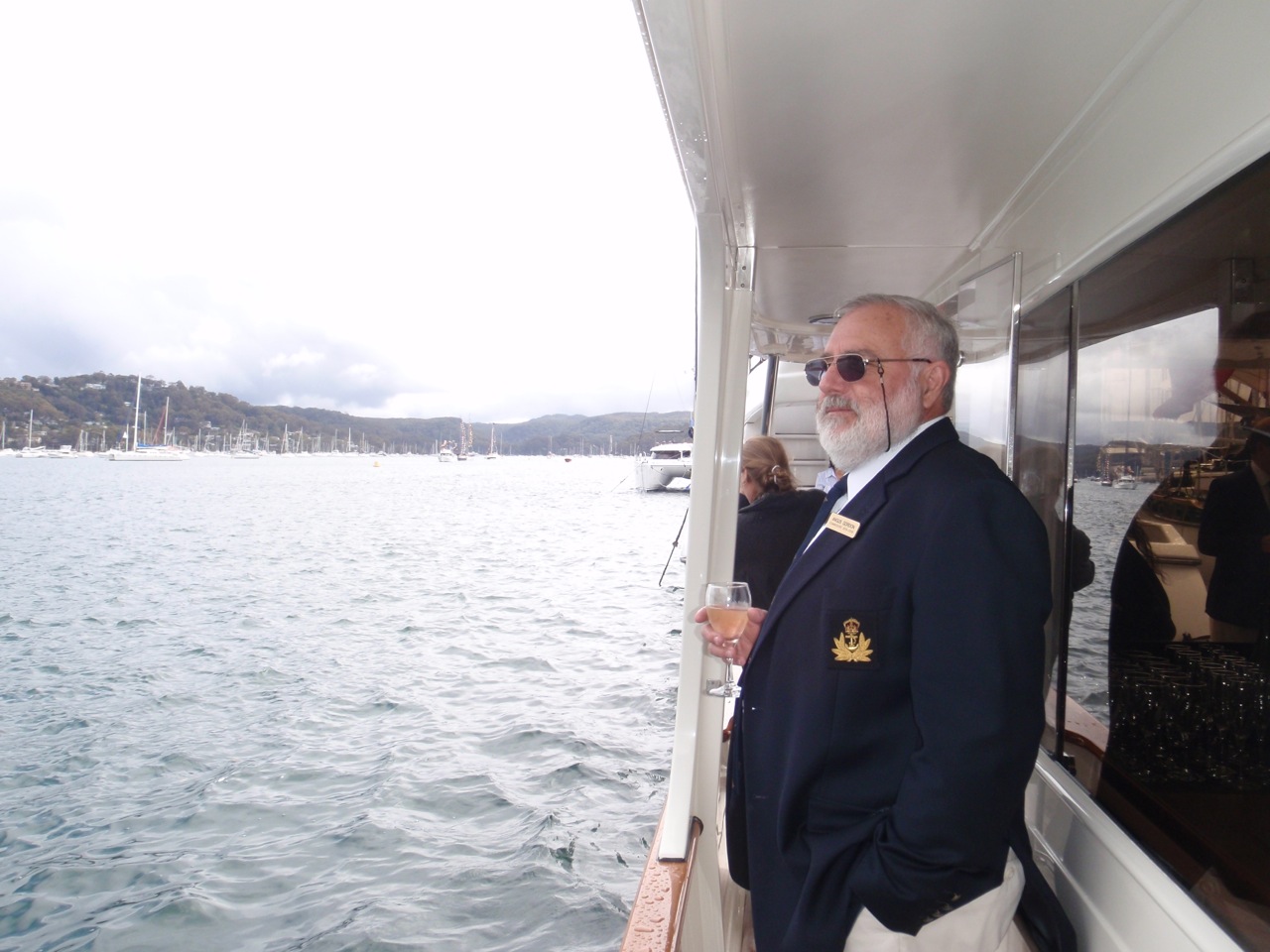
Commodore on open day at RPAYC
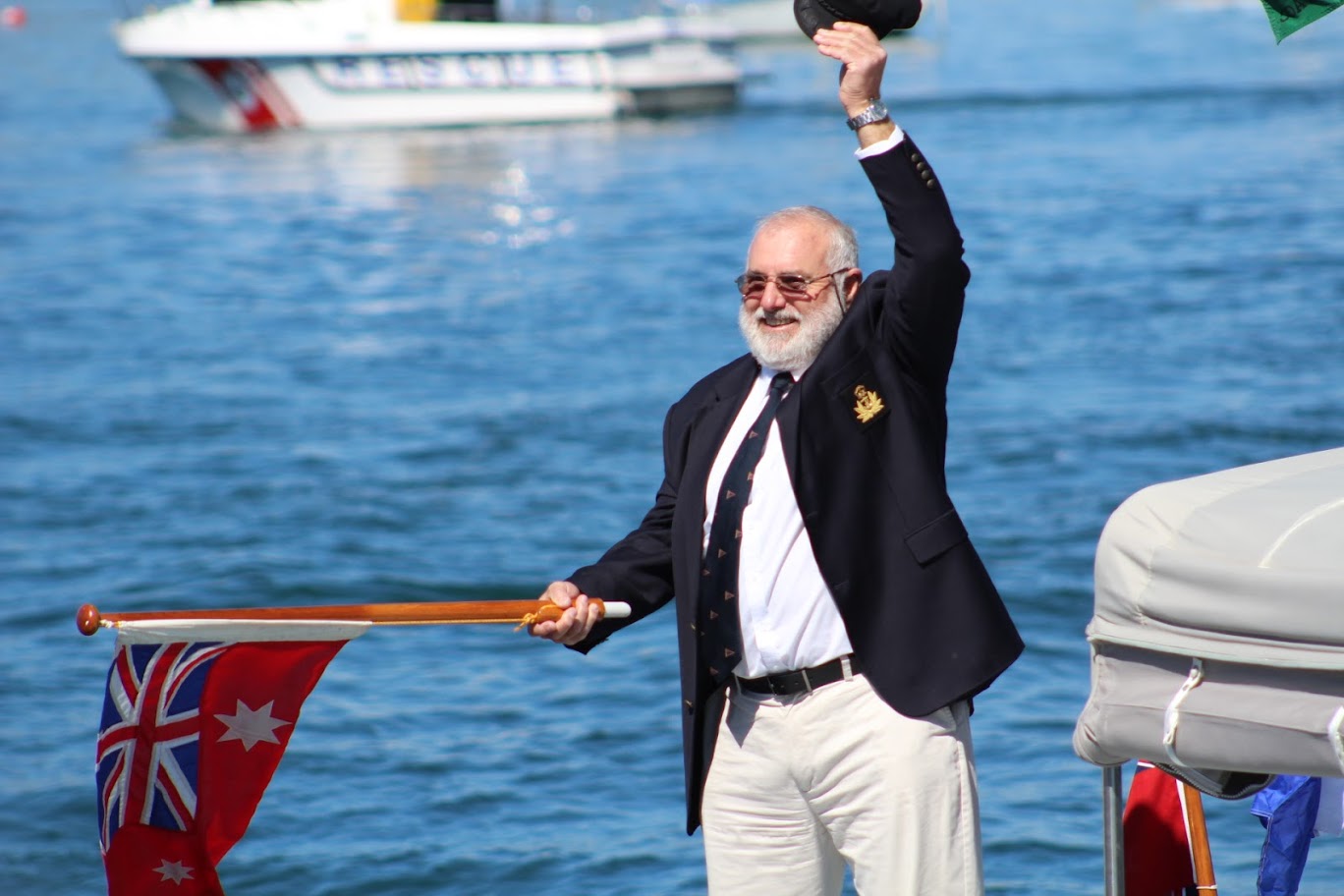
Commodore on open day at RPAYC 2017
You have also written about sailing, penning the 2010 released 'Racing to Coffs - Memoirs of a Coffs Race Addict' to celebrate 30 years of the RPAYC’s Coffs race?
Yes (laughs) – I had a brain snap and a bit of boredom and met it with that! (laughs)
This shares the history of the race until then as well as what the weather conditions can be, what to do tactically, how to prepare your boat and crew, that sort of essentials information.
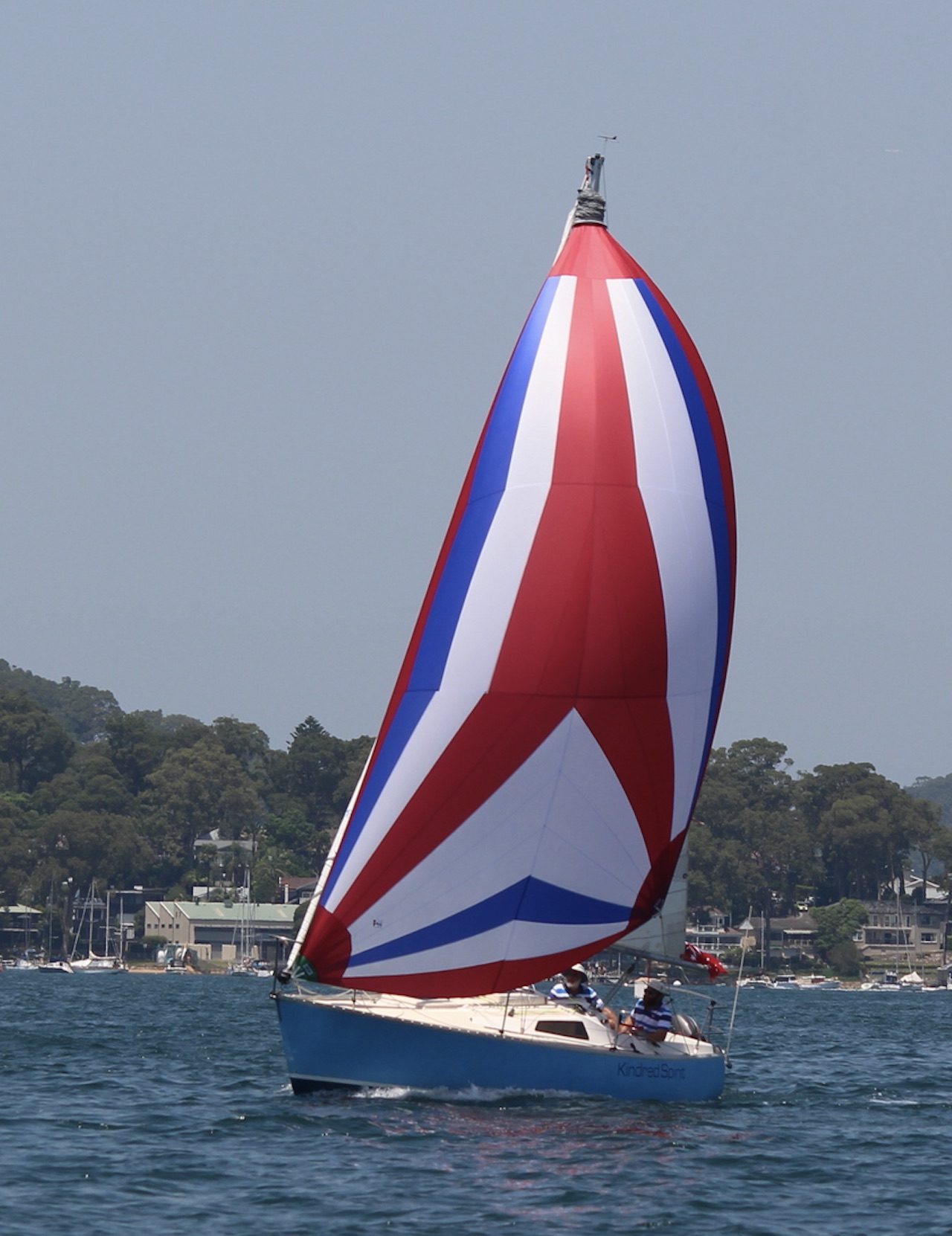
Kindred Spirit in flight
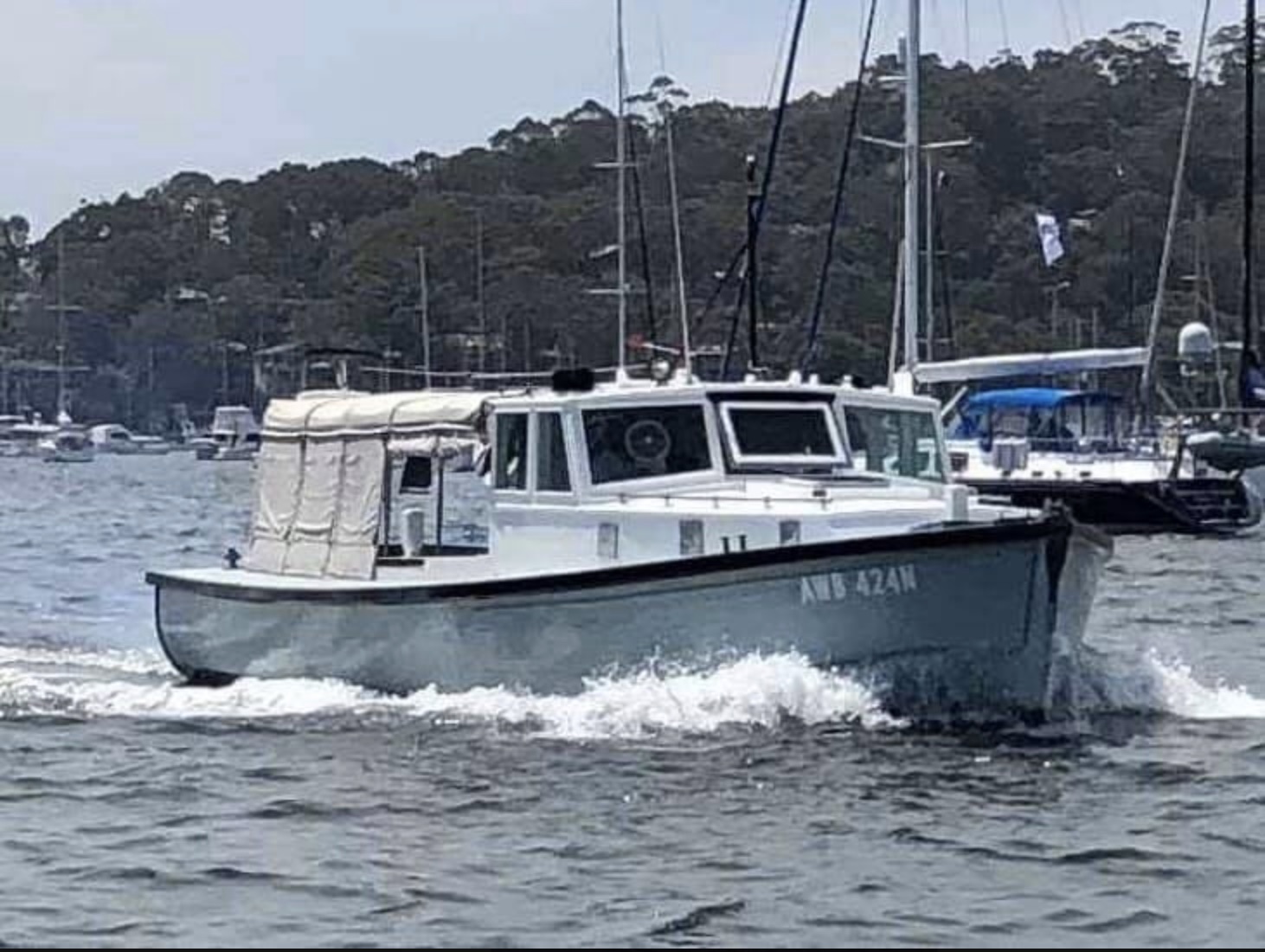
WW2 Navy boat AWB 424N my youngest son purchased from the Navy and which we are currently restoring.
Have you slowed down any now Angus?
The problem is I’m now in a 74-year-old body and still have a 21-year-old mind.
What are you working on at the moment?
Presently I have two conferences to present to, virtually, in America – that means presenting papers using Zoom, which has, and will be a very interesting experience, and yesterday I finished the First Draft of another paper, and there’s another one that a friend of mine is trying to get me involved in. There are other works around this as well but the main thing I’m trying to do is get some of my experiences and knowledge down on paper so that may be accessed for use by other people.
It’s a phenomenal amount of work you have done backed up be a catalogue of papers – I don’t know how you do it all…
They used to call me ‘Eveready’.
I suspect they still do! ‘used to’ indeed – so you’re a grandfather now; how many grandchildren?
Six, all boys. They range in age form 17 down to 7 months. We’ve been blessed, that’s for sure.
What are your favourite places in Pittwater and why?
Broken Bay itself – because that’s where the Coffs Race starts. Frankly though there are so many places in Pittwater that I love it would have to be all of it. If I had to name just one favourite it would have to be Winnererremy Bay, due to the work we did in saving that, it’s very important, as is the Warriewood Escarpment and the Wetlands, for the same reason.
What is your ‘motto for life’ or a favourite phrase you try to live by?
If you haven’t done it before, and it’s really frightening, get into it!
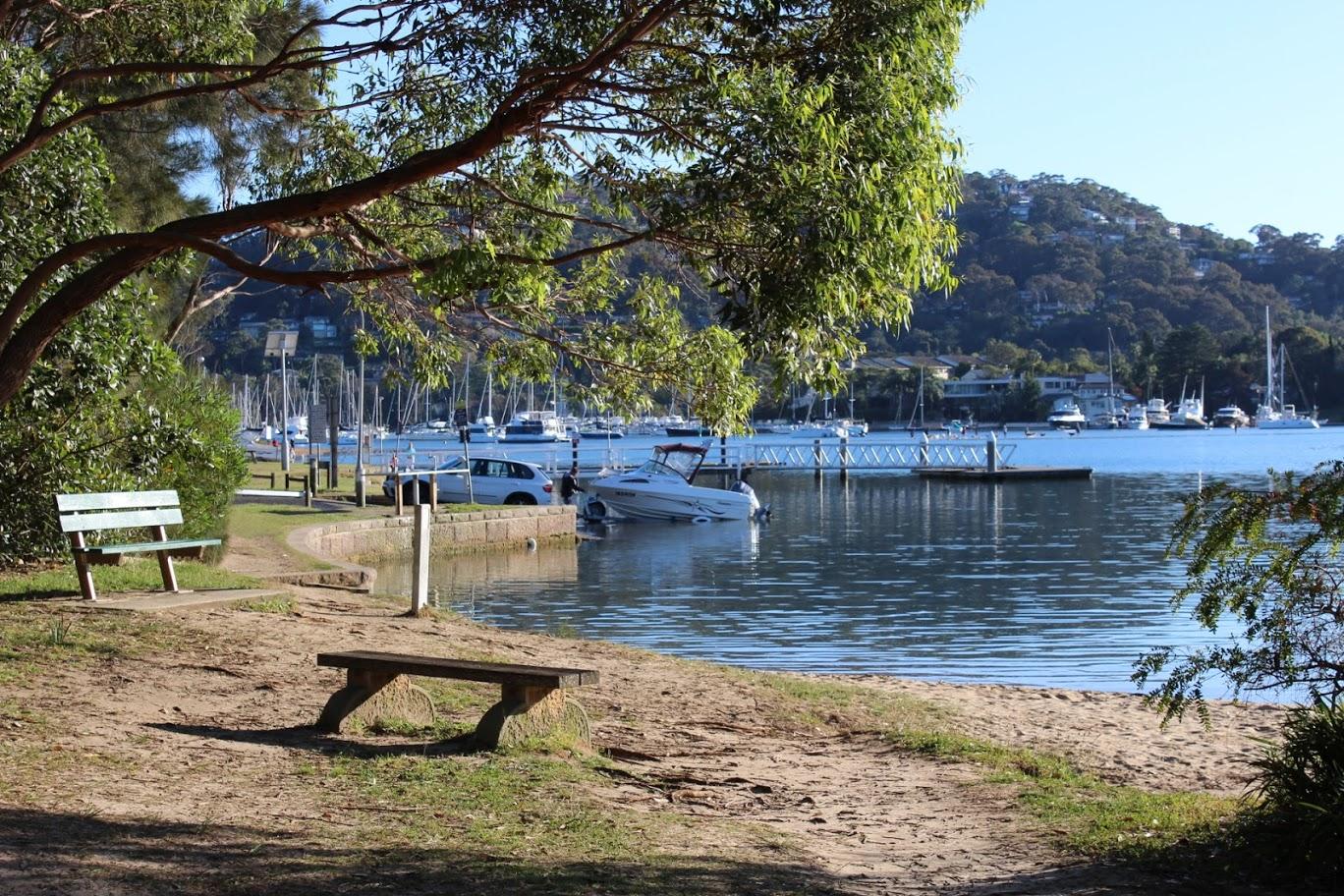

Angus Gordon Walkway is a 1,789 foot trail through Warriewood Wetlands. It can be accessed by foot and bicycle.
Angus Donald Gordon
North Narrabeen NSW
Education
- 1969 B.E. (Civil), The University of New South Wales,
- 1972 M.Eng.Sc. (Water and Coastal), The University of New South Wales
- 1985 Executive Development Course, Institute of Administration,
- 1987 Management of Research and Development, Inst. of Administration,
Professional History
- 1996-2005 Chief Executive Officer, Pittwater Council
- 1995-1996 Business Development Manager, AWT EnSight
- 1994-1995 Manager, Private Sector Infrastructure, Public Works
- 1993-1994 Manager, CEO Executive Support, Public Works
- 1986-1993 Director, AWACS Pty Ltd., Manager Manly Hydraulics Laboratory
- 1977-1986 Inspecting Engineer, Public Works
- 1977 Antarctic Division
- 1976-1977 Supervising Engineer, Public Works
- 1973-1975 Project Engineer, Manly Hydraulic Laboratory
- 1972-1973 Water and Sewerage Design Engineer, Shoalhaven Shire Council
- 1972 Lecturer, Civil Engineering, Uni of NSW
- 1970-1972 Project Engineer Water Research Laboratory, Uni of NSW
- 1966-1970 Full Time Civil Engineering Degree
- 1964-1966 Commercial Management Trainee Qantas Airways
Coastal Planning Experience
Engineering
- Byron Bay (NSW) - 1977-1979, 2000
- Tweed Heads (NSW) - 1983-1989
- New Brighton (NSW) - 1977-1979
- Warringah Shire - 1982-1984
- Tathra (NSW) - 1980
- Cronulla (NSW) - 1977-Present
- Hawks Nest (NSW) - 1982-1984
- Sydney (NSW) - 1989
- NSW Coastal Zone Management Policy - 1977-1986
- Jerudong (Brunei) – 1991, 1992, 1993
- Jakarta (Indonesia) 1994
Estuary, River and Wetlands Management
- Forster/Tuncurry (NSW) - 1979-1980
- Dee Why (NSW) - 1977-1982
- Warriewood (NSW) 1979-Present
- South West Rocks (NSW) - 1985
- Lake Burrill (NSW) - 1972
- Shuwalkh (Kuwait) - 1990
- Shoalhaven (NSW) 1973-Present
- Jakarta (Indonesia) - 1994-1995
- Dubai (UAE) – 1995
Sediment Transport-Coastal process studies, sand movement onshore/offshore, longshore and beach erosion
- Newcastle Bight (NSW) - 1974-1977
- Hawks Nest (NSW) - 1982
- Wamberal (NSW) - 1978, 1984
- Cronulla (NSW) - 1977-Present
- Byron Bay (NSW) - 1977, 1978
- Carama Inlet (NSW) - 1989
- Tathra (NSW) - 1980
- Fly Point (NSW) - 1989
- Broken Bay (NSW) - 1981
- Tweed Heads (NSW) - 1989
- Burnie (Tas) - 1981
- Somers (VIC) - 1991
- Hawks Nest (NSW) - 1982
- Belmont (NSW) - 1991
- Sydney Shelf (NSW) - 1979
- Jerudong (Brunei) - 1991
- Wave Climate Studies
- Bombo (NSW) - 1970
- Pilot Bay (Tas) - 1971
- Sand Bypassing Studies
- Tweed Heads (NSW) - 1989, 1990
- Shoalhaven (NSW) - 1974
- Kempsey (NSW) - 1973
- Narrabeen (NSW) - 1987
- Woden Valley (ACT) - 1975
- Manning (NSW) - 1989
Shelf Currents Studies
Various Studies on NSW Shelf (Tweed, Coffs, Gosford, Sydney, Illawarra)
Outfall Monitoring/Studies
- Sydney (North Head/Bondi/Malabar) (NSW) - 1987-1993
- Illawarra (NSW) – 1991
- Hong Kong - 1995
Climatic Change
Various research studies on Climatic change Input; sea level; coastal erosion; flooding)
- 1980-Present Marina Studies
- Southport Yacht Club (Qld) - 1991
- Royal Prince Alfred YC (NSW) 1992, 1993
OAM Citation
Mr Angus Donald GORDON
North Narrabeen
For service to environmental management and planning, and to the community.
Service includes:
- Member, Coastal Expert Panel, advising the Minister for Planning, Parliament of New South Wales, current.
- Chair, New South Wales Coastal Panel, Office of Environment and Heritage, New South Wales Government, 2013-2016.
- Chair, Industry Advisory Committee, Water Research Laboratory, University of New South Wales, current.
- Former Member, National Committee, Coastal and Ocean Engineering, Engineers Australia.
- Chief Executive Officer/General Manager, Pittwater Council, 1996-2005.
- Founding President, Down Syndrome Association of New South Wales, 1979-1980.
- Manager, Infrastructure and Executive Support, 1994-1995
- Manager, Director General's Office, 1993-1994.
- Supervising Engineer Coastal, 1975-1986.
- Director, Australian Water and Coastal Studies Pty Ltd, 1986-1992.
- Manager, Manly Hydraulics Laboratory, 1986-1992.
- Member, National Safety Committee, Sailing Australia, 2012-2016.
- Former Vice-President and Member, Advisory Committee, Yachting New South Wales.
- Commodore, 2005-2008.
- Board Director, 2003-2008.
- Creator, 'Schools Learn to Sail Program' and 'Youth Development Program', 1992-1993.
- Member since 1989.
'Racing to Coffs: Memoirs of a Coffs Race Addict', (Sydney, 2010)
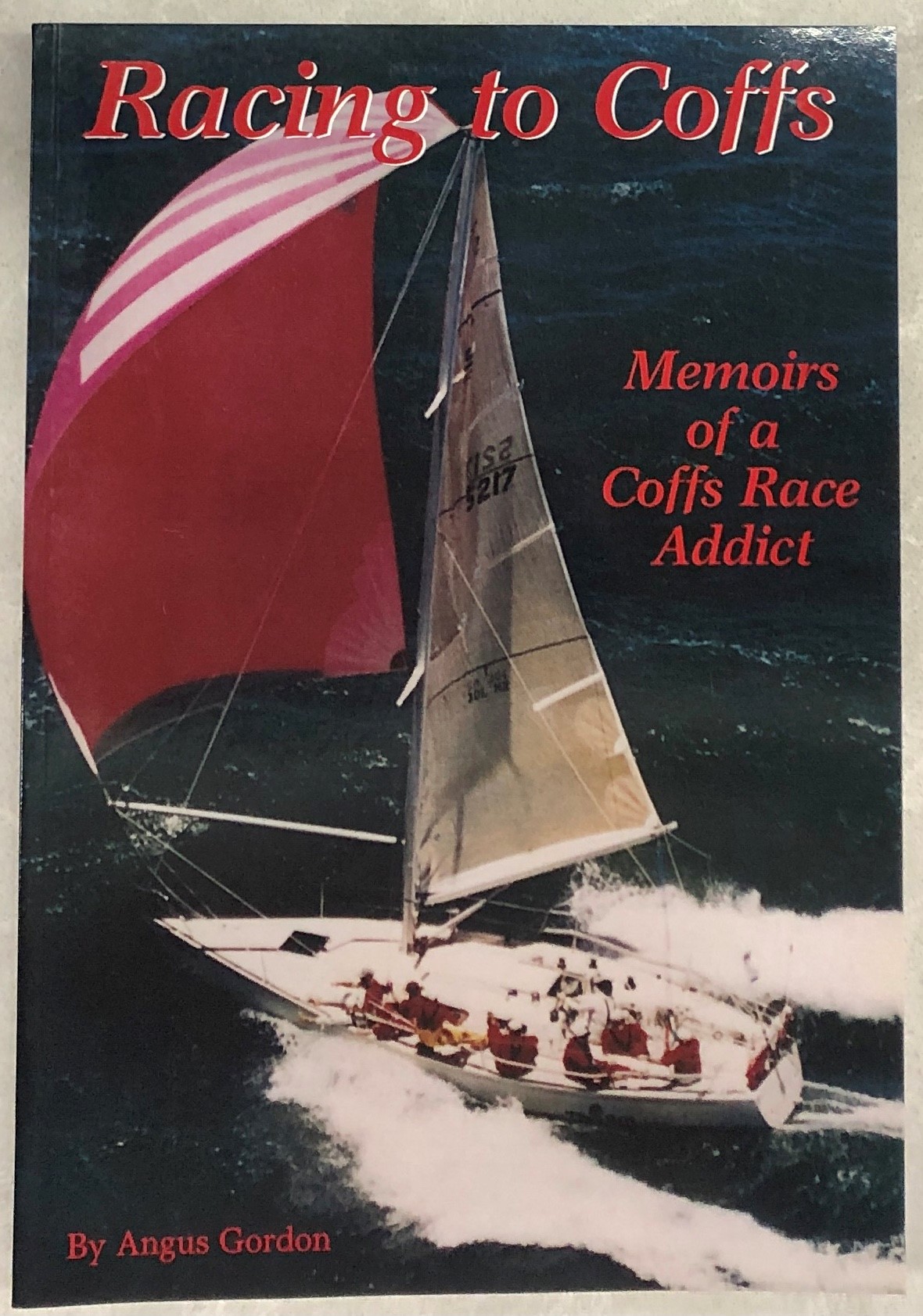
Completing a Civil Engineering degree in 1969. Angus commenced work on water and coastal projects in 1970. In 1973 he obtained a Master of Engineering Science. For 40 years he has been involved in coastal engineering, coastal zone management and planning projects in all states of Australia and in Brunei, Dubai, Kuwait, Indonesia and Hong Kong.
In 1976 he established the NSW Governments Beach Improvement Program and led the team that, in 1978 produced NSW’s first comprehensive costal investigation and management study the “Byron Bay – Hastings Point Erosion Study". As a direct result of that study Angus then became involved in the drafting and implementation of the 1979 NSW Coastal Protection Act. Angus has 56 technical papers published nationally and internationally on coastal engineering and coastal zone management.
First becoming involved in the issue of climate change in 1976, he was seconded to the Antarctic Division of the Department of Science for a 12 month period. In 1987 he published a paper as a chapter in the CSIRO’s book “Greenhouse 87”; the paper linked sea level rise to coastal erosion at 32 locations in NSW where his team had undertaken studies over the preceding decade. A number of his published papers are concerned with climate change and was the lead author of the Engineers Australia 1991 guidelines for adaption to climate change in the coastal zone.
For 9 years prior to his retiring from the position in 2005 he was General Manager of Pittwater Council. Angus also has served as a committee member of the Warriewood Residents Association.
He was a Keynote Speaker at the first Australian Conference on Practical Adaption to Climate Change and is currently Chairman of the Industry Advisory Board to the University of NSW’s Water Research Centre.
PITTWATER COUNCIL
Roads Act 1993
Naming of Public Roads - Lucinda Place, Maybanke Court and Eric Green Drive
IN accordance with Clause 162 of the Roads Act 1993, it is notified that, after consideration of all submissions lodged, the Council, at its meeting of 17th April, 2000, approved the naming of the following roads: Description
New roads within the Winnererremy Bay Parkland Estate Subdivision.
Names; Lucinda Place; Maybanke Court; Eric Green Drive. A. GORDON, General Manager, Pittwater Council, PO Box 882, Mona Vale, NSW 1660.PITTWATER COUNCIL (2000, April 28). Government Gazette of the State of New South Wales (Sydney, NSW : 1901 - 2001), p. 3668. Retrieved from http://nla.gov.au/nla.news-article231987086
PITTWATER COUNCIL
Local Government Act 1993 Vesting of Land in Council Public Garden and Recreation Space Provided for in Subdivision.
THE Pittwater Council hereby gives notice, pursuant to subsection 50 (4) of the Local Government Act 1993, that the land described in the Schedule below is vested in the Council for an estate in fee simple, and is taken to be dedicated as a public reserve. A. GORDON, General Manager, Pittwater Council, Units 9, 11 and 12, 5 Vuko Place, Warriewood, NSW 2102.
SCHEDULE
The land is Lot 35 in Deposited Plan 11784, Parish of Narrabeen, County of Cumberland, being the land on the plan of subdivision of part of Portion 63 in the Parish of Narrabeen* County of Cumberland, covered by Shire Clerk's Certificate No. 329 of 6th April, 1923, approval is subject to the 17 acres, 2 roods, 24 perches described as "park" being dedicated to the Council. PITTWATER COUNCIL (2000, June 2). Government Gazette of the State of New South Wales (Sydney, NSW : 1901 - 2001), p. 4766. Retrieved from http://nla.gov.au/nla.news-article231996431
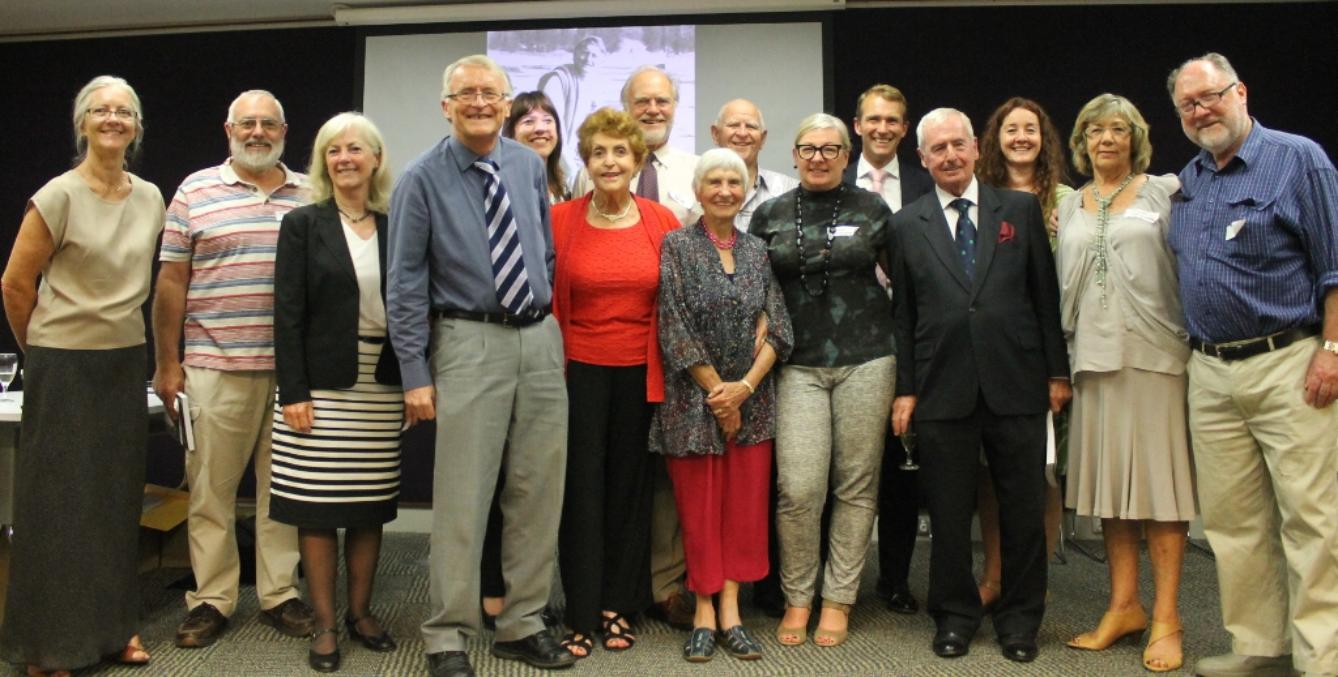
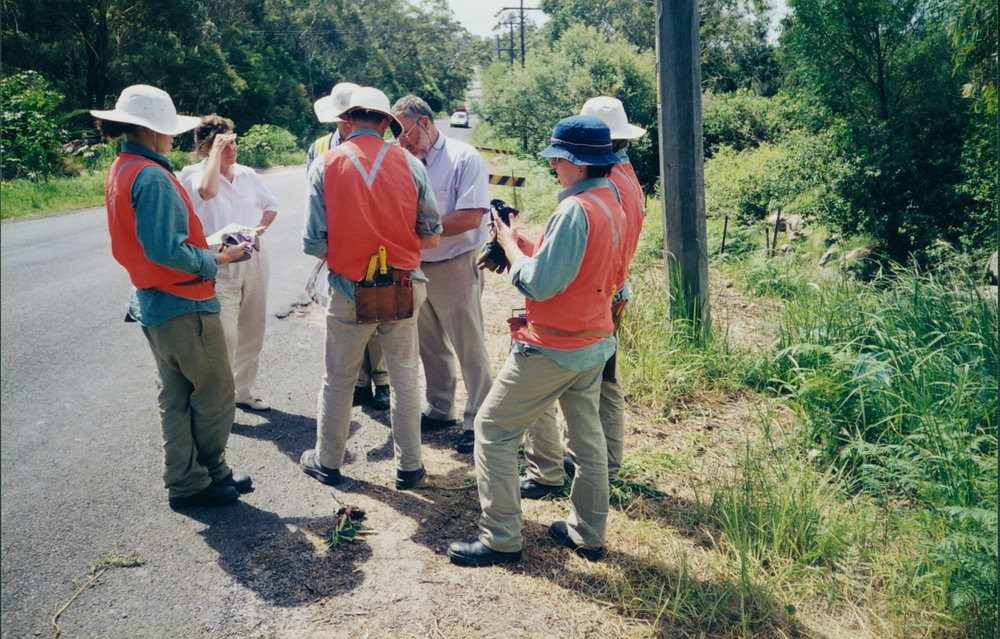
2001 - GM at Pittwater Council
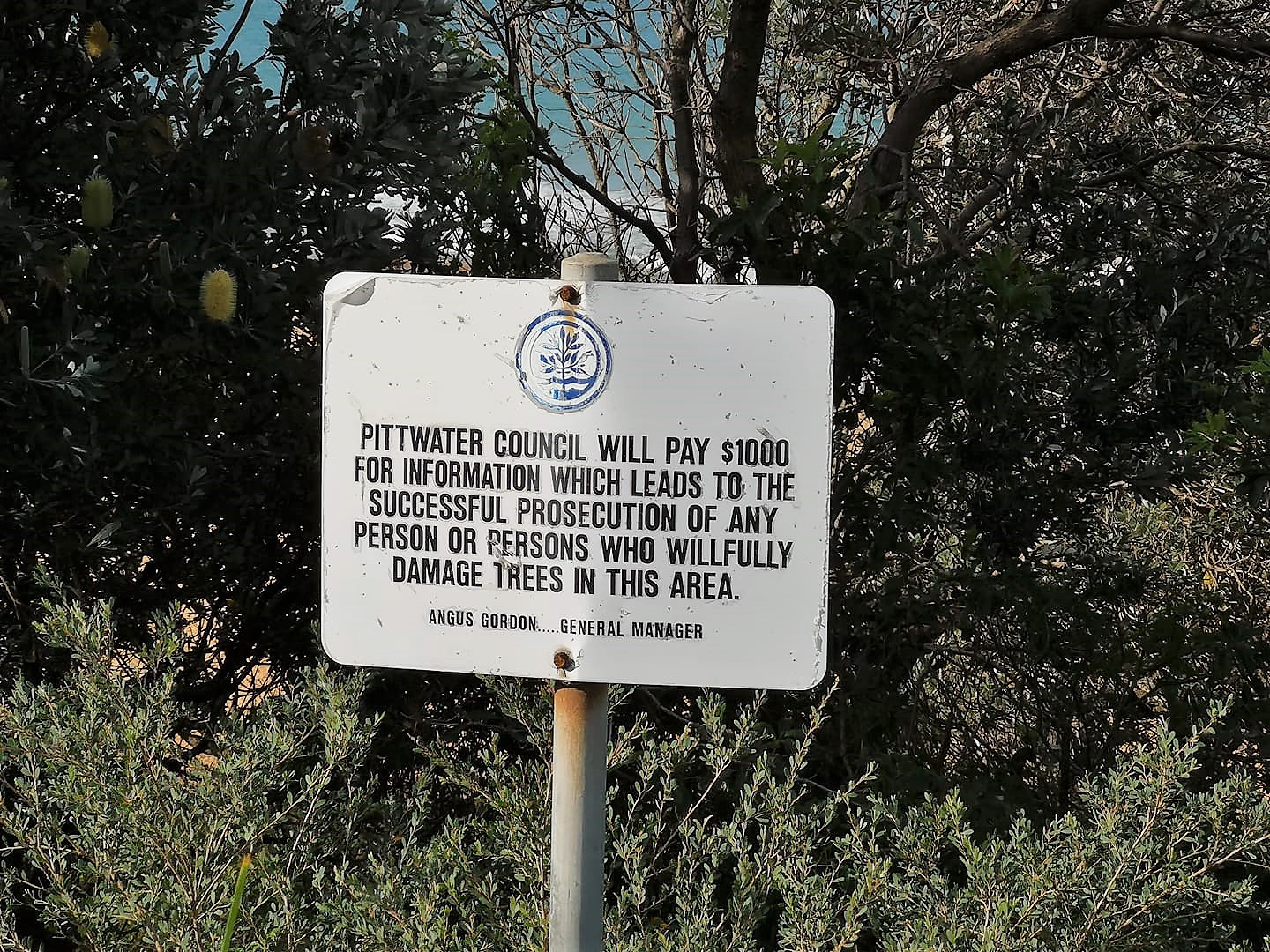
1974 'Sygna' Storm
Named for bulk carrier - From AMSA;
On Sunday 26 May 1974 the 53,000 tonne Norwegian bulk carrier Sygna was anchored off the Port of Newcastle, Australia, waiting to load fifty thousand tonnes of coal destined for Europe. The ship had 2136 tonnes of bunker oil and 163 tonnes of diesel oil on board. A gale warning had been issued and of the 10 ships waiting off the port, seven had weighed anchor and moved out to sea.
Winds of up to 70 miles per hour and the largest swell conditions ever seen at the port’s entrance were recorded, with a wave height of over 17 metres.
The conditions resulted in the Sygna dragging anchor and drifting eleven kilometres sideways in half an hour before grounding 130 metres off Stockton Beach. The Sygna lost 700 tonnes of bunker oil at the time of the grounding. This oil was generally dispersed by heavy seas and no clean up or recovery action was initially required.
As soon as the storm and the sea subsided, the stern settled in deep water. The ship was initially considered too large to be salvaged and the wreck was declared a total loss and left in place. A helicopter from Williamstown RAAF base lifted the crew of thirty to safety with no injuries or loss of life.
On 4 September a salvage team led by Japanese millionaire Kitoku Yamada refloated the ship after repairing several holes in the hull and pumping out thousands of tonnes of water. The stern section was refloated first, followed by the bow, which had been resting deep in the sand. The bow remained afloat but unfortunately for the salvagers the stern again went aground about 80 metres out from the beach and gradually settled in the sand as salvage crews stripped it of all items of value. After lying in Salamander Bay, Port Stephens, for almost two years the bow section was towed away and broken up in Taiwan.
During late September and early October there were several failed attempts to salvage the stern, which was driven back ashore by bad weather and continued to leak oil, affecting approximately five miles of beach. Beach cleaning was carried out by bulldozers.
Following further salvage attempts of the stern in November, very heavy oil spillage occurred, spreading along the beach up to 10 miles north of the site. Response was limited to further beach clean-up by bulldozer, with oil buried in the sand above the high water mark.
Locally:
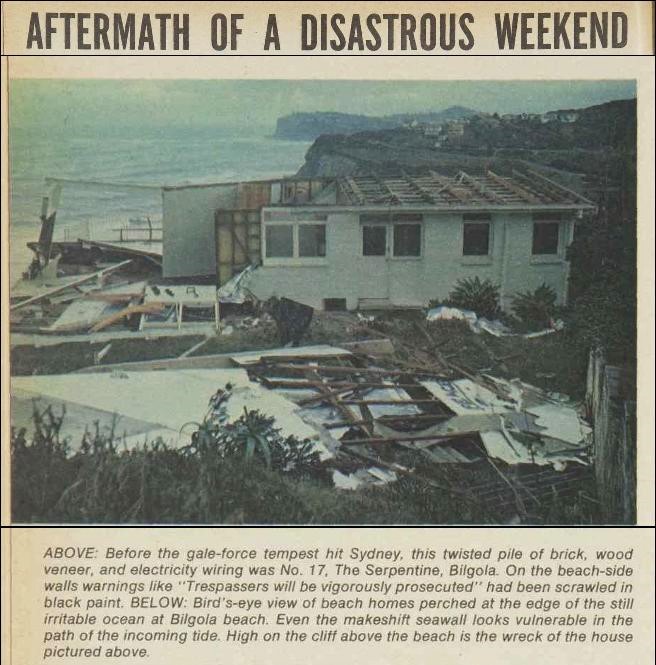
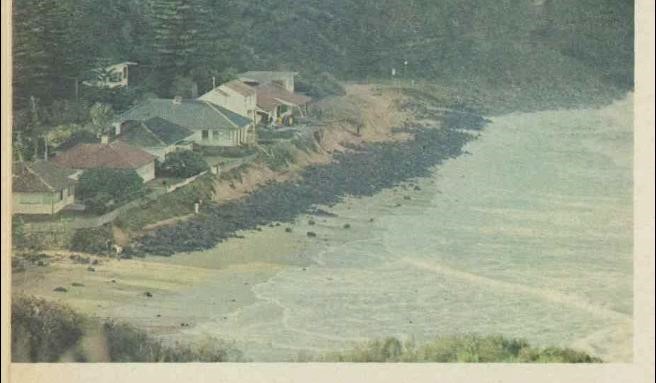
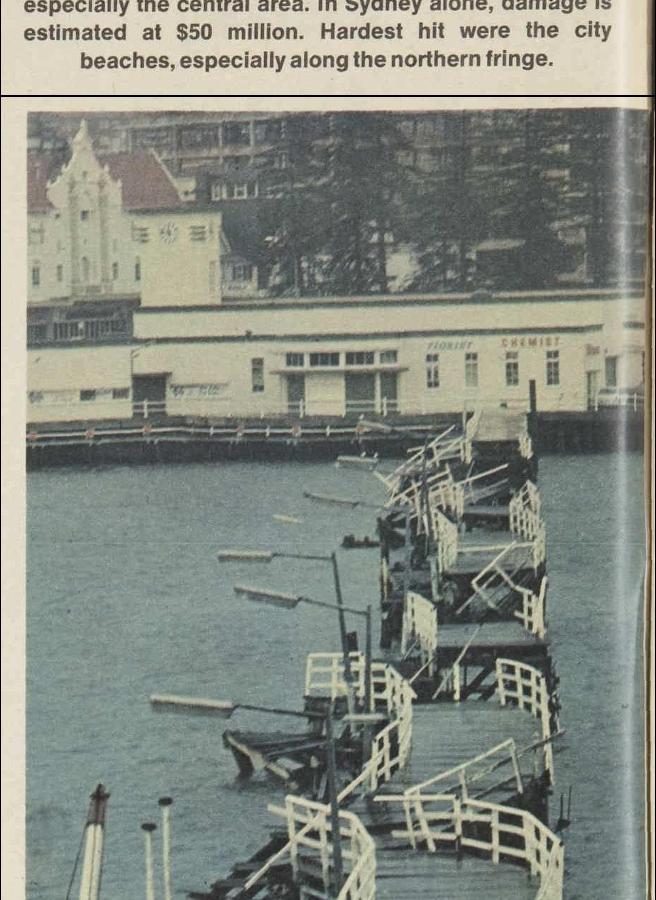
AFTERMATH OF A DISASTROUS WEEKEND (1974, June 12). The Australian Women's Weekly (1933 - 1982), p. 8. Retrieved from http://nla.gov.au/nla.news-article44557918
Winnererremy Bay: Angus Gordon - Sequel To 'Dorothy Hawkins' Film
John states in the information listed for this film:
Angus Gordon was General Manager of breakaway Pittwater Council from 1996 to 2005. He turned the new council around. Central was the successful development of Winnererremy Bay into both residential area and beautiful public park, a work almost of genius given that Warringah Council had botched the initial public land resumption in favour of a dodgy commercial development focussed on a 'boatel' and marina development. When that failed the NSW State Government prepared a residential development of up to 300 blocks. Resident opposition and some clever footwork by the new Council instead produced a public good. Lightly edited, this film offers rare insight into processes that govern us that are more usually obscure to the general public.